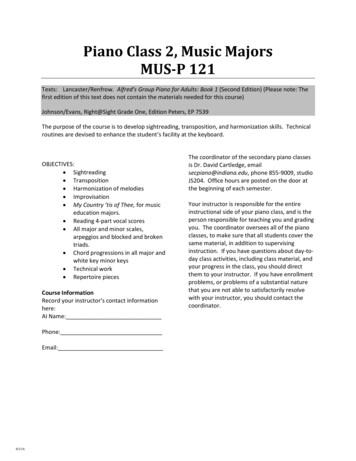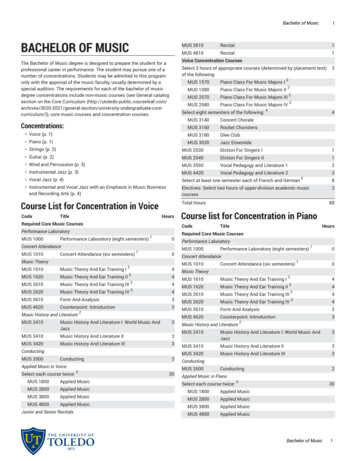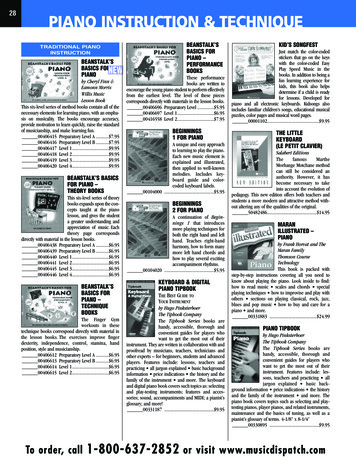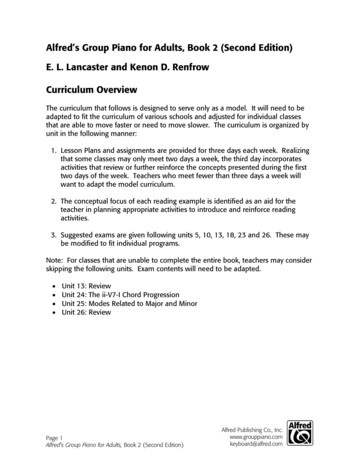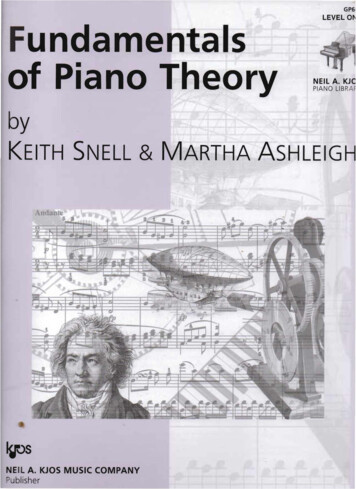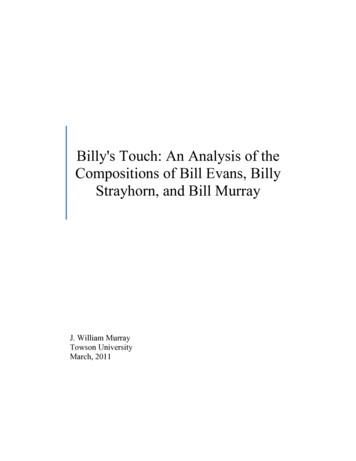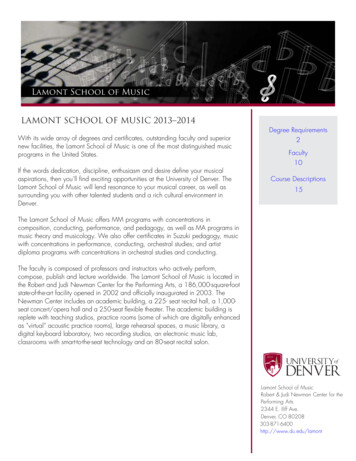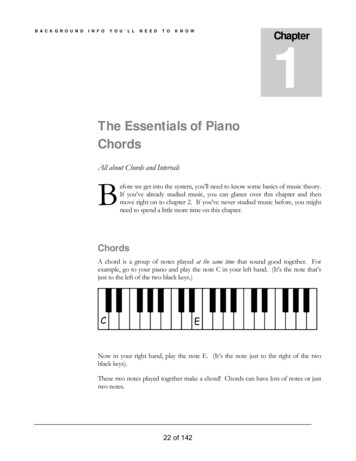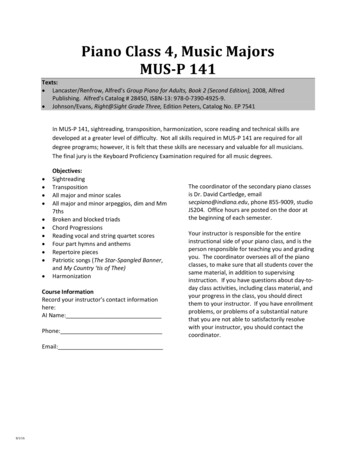
Transcription
Piano Class 4, Music MajorsMUS-P 141Texts: Lancaster/Renfrow, Alfred’s Group Piano for Adults, Book 2 (Second Edition), 2008, AlfredPublishing. Alfred’s Catalog # 28450, ISBN-13: 978-0-7390-4925-9. Johnson/Evans, Right@Sight Grade Three, Edition Peters, Catalog No. EP 7541In MUS-P 141, sightreading, transposition, harmonization, score reading and technical skills aredeveloped at a greater level of difficulty. Not all skills required in MUS-P 141 are required for alldegree programs; however, it is felt that these skills are necessary and valuable for all musicians.The final jury is the Keyboard Proficiency Examination required for all music degrees. Objectives:SightreadingTranspositionAll major and minor scalesAll major and minor arpeggios, dim and Mm7thsBroken and blocked triadsChord ProgressionsReading vocal and string quartet scoresFour part hymns and anthemsRepertoire piecesPatriotic songs (The Star-Spangled Banner,and My Country ‘tis of Thee)HarmonizationCourse InformationRecord your instructor’s contact informationhere:AI Name:Phone:Email:8/1/16The coordinator of the secondary piano classesis Dr. David Cartledge, emailsecpiano@indiana.edu, phone 855-9009, studioJS204. Office hours are posted on the door atthe beginning of each semester.Your instructor is responsible for the entireinstructional side of your piano class, and is theperson responsible for teaching you and gradingyou. The coordinator oversees all of the pianoclasses, to make sure that all students cover thesame material, in addition to supervisinginstruction. If you have questions about day-today class activities, including class material, andyour progress in the class, you should directthem to your instructor. If you have enrollmentproblems, or problems of a substantial naturethat you are not able to satisfactorily resolvewith your instructor, you should contact thecoordinator.
Page 2, MUS-P 141STUDENT RESPONSIBILITIESJury and Hearing dates: As juries and hearings areone-on-one events, they are scheduled outside ofclass time, by appointment with your instructor.Your instructor will likely arrange a time during class,by email, or by posting a signup sheet. Theapproximate dates of these events are set forth inthe following syllabus. If you have a conflict withany of these dates, let your instructor know early.Instructors are not obligated to make up juries andhearings.Preparation: This syllabus is devised so that you canprepare for class material ahead of time. Forexample, you are expected to have preparedmaterial for week three, and be ready to play it forthe first class period of that week. Your instructorwill announce those items required for preparationfor each class period, and it is expected that you willprepare these items. If you are absent for anyreason, it will be assumed that you are using thissyllabus to keep up with class content.Practice: It is expected that students in secondarypiano classes will practise an average of 30 to 40minutes per day. Some students will require moretime, others less. Do NOT try to “cram” at the lastminute. Piano playing, like any physical skill,requires continual reinforcement, and cannot be“crammed.” Practice time can be scheduled tmlParticipation: This is a laboratory environment. Itcannot function if students are not prepared, or aredistracting. Therefore, points are assigned forparticipation in class. If you are absent, late,unprepared, or uncooperative in class, yourinstructor will assess you accordingly.Need help? Your instructor keeps office hours, eitherat a particular time, or by appointment. Make use ofthese hours—get your money’s worth from theclass!Disabilities: If you require assistance or appropriateacademic accommodations for a disability, pleasecontact the instructor after class, during office hoursor by individual appointment. You must haveestablished your eligibility for disability supportservices through the Office of Disability Services forStudents in W302 Wells Library, 855-7578.Religious Observances: If a jury, hearing orassignment is scheduled on a religious holiday youobserve, please inform your instructor during thefirst two weeks of class so that reasonableaccommodations can be made.GRADING SYSTEMTogether, jury, hearing and instructional days total400 points:Daily class scores:3 hearings at 30 points each:1 Midterm jury:1 Final jury:130 points90 points90 points90 pointsUp to 5 points are assigned for each instructionalday. These points are at the discretion of theinstructor and reflect attendance, participation andpreparation. Your attendance at the class is mostimportant for your progress as well as assessment.Your lowest two class day scores will be droppedfrom calculation of your grade. This dropping ofyour lowest two scores is intended to provideprotection against missed class days due to illness orequivalent need. All class days which are missed willbe scored zero. Students who add the class late willhave classes scored beginning at the date ofregistration.Your grade will be figured as follows:A 392 or aboveC 319-304A391-376C303-292A-375-360C-291-280B 359-344D 279-264B343-332D263-252B-331-320D-251-240F239 or below
MUS-P 141, Page 3STUDENTS NEEDING TO LEARN PATRIOTIC SONGS SHOULD START AT THE BEGINNING OF THE SEMESTERClass time is NOT for practice. You should come to class prepared.WEEK 1Repertoire: Bagatelle, pp. 186–187Technique: C, G, D, A and E Major scales, arpeggios, blocked and broken chords (pp.184–5). All scales should be four octaves. Arpeggios and chords are threeoctaves.Reading: Right@Sight (chosen by instructor)p. 188, nos. 1 and 2 (Sonatina)Harmonization and p. 190, no. 1Transposition:Improvisation: Bourée, p. 189Score Reading: Glory to God (from Messiah), p. 191WEEK 2Instructor announces material for first hearingRepertoire: Continue BagatelleThe Pioneer Spirit, pp. 196–197Technique: F, B, G (F ) and D Major scales, arpeggios, blocked and broken chords (p.198). Continue previous technique.Reading: Right@Sight (chosen by instructor)p. 199, nos. 1 and 2 (Minuet)Harmonization and Emperor Waltz, p. 200Transposition: Over the River, p. 203Score Reading: The Carnival of Venice, p. 193Ensemble: In the Good Old Summer Time, pp. 204–205*Parts to be assigned first class day of the week, performance on the secondclass day. Learn more than one part, so that you can switch parts and enjoymore of the piece.
Page 4, MUS-P 141WEEK 3Repertoire: Continue The Pioneer SpiritDuet: Allegro, p. 213 (your instructor will assign parts)Technique: B , E and A Major scales, arpeggios, blocked and broken chords (pp. 206–207). Continue previous techniqueDiminished Seventh arpeggios, p. 207 (practice in three octaves)Reading: Right@Sight (chosen by instructor)p. 209, nos. 1 and 2 (Dance)Harmonization and Meet Me in St. Louis, Louis, p. 210Transposition:Score Reading: Dies Irae, p. 202FIRSTHEARINGThe Hearing takes place outside of class, by appointment with yourinstructor. Hearing Content to be announced by your instructor at thebeginning of Week 2WEEK 4Repertoire: Continue the duet: AllegroAccompaniment to Dawn of a New Day, pp. 216–217 (find someone toaccompany!)Gigue, p. 221Technique: c, g, d, a and e minor scale, arpeggios, blocked and broken chords (pp. 219–220). Continue previous technique (including diminished sevenths)Reading: Right@Sight (chosen by instructor)p. 222, nos. 1 (Beethoven’s German Dance) and 2 (Haydn’s German Dance)Harmonization and Waltz, p. 223Transposition:Score Reading: Rainy Day Song, p. 215Celestial Music, p. 218
MUS-P 141, Page 5WEEK 5Instructor announces material for second hearingRepertoire: Continue GigueScherzo, pp. 230–231Technique: Diminished seventh arpeggios, p. 229 (three octaves)Dominant seventh arpeggios, p. 106 (three octaves)b and f minor scales, arpeggios, blocked and broken chords (p. 233)Continue all previous techniqueReading: Right@Sight (chosen by instructor)p. 234, nos. 1 and 2 (Etude)Harmonization and Für Elise, p. 237Transposition:Score Reading: Symphony No. 7, p. 244WEEK 6Repertoire: Continue ScherzoArabesque, pp. 362–363Technique: Diminished seventh arpeggio on F, p. 249, no. 3 (three octaves)Dominant seventh arpeggios, p. 120 (three octaves)Continue all previous techniqueReading: Right@Sight (chosen by instructor)p. 235 nos. 1 (Spanish Dance) and 2Harmonization: Let Us Break Bread Together, p. 238Improvisation: p. 239, nos. 1 and 2Score Reading: Die Himmel Erzählen die Ehre Gottes, p. 240Ensemble: Alexander’s Ragtime Band, pp. 241–243*Parts to be assigned first class day of the week, performance on the secondclass day. Learn more than one part, so that you can switch parts and enjoymore of the piece.SECONDHEARINGThe Hearing takes place outside of class, by appointment with yourinstructor. Hearing Content to be announced by your instructor at thebeginning of Week 5
Page 6, MUS-P 141WEEK 7Repertoire: Continue ArabesqueAccompaniment to Sehnsucht nach dem Frühlinge, p. 254 (find someone toaccompany!)Technique: f , c , g , b and e minor scales, arpeggios, blocked and broken chords (p.249). Continue all previous techniqueReading: Right@Sight (chosen by instructor)p. 251, nos. 1 (Andantino) and 2 (Pyrenees Melody)Score Reading:WEEK 8Quartet No. 17, p. 253Wenn so lind dein Aug emir, p. 255Reminder: midterm jury is coming up!Repertoire: Continue Sehnsucht nach dem FrühlingeSeascape, p. 261Technique: Review all technique:All 24 major and harmonic minor scales, four octavesAll 24 major and minor arpeggios, three octavesAll 24 blocked and broken chords, three octavesDominant and diminished seventh arpeggios starting on white notes, threeoctavesReading: Right@Sight (chosen by instructor)p. 262, nos. 1 (Etude) and 2 (Lullaby)Harmonization: Morning has Broken, p. 264Score Reading: Agnus Dei, p. 278
MUS-P 141, Page 7WEEK 9Repertoire: Continue SeascapeAccompaniment to To A Wild Rose, pp. 378–379 (find someone toaccompany!)Technique: Review all scales, arpeggios, blocked and broken chords, including dominantseventh and diminished seventh arpeggios starting on white notesReading: Right@Sight (chosen by instructor)German sixths: progression, p. 268 and reading exercise, p. 269Italian Sixths: progression, p. 270 and reading exercise, p. 271Harmonization and Alberti bass exercise, p. 269Transposition: Sonata, p. 271Score Reading: Quartet No. 17, p. 279The midterm jury will be arranged by appointment with your instructor, andwill be heard by a panel of Instructors. It should take place towards the endof Week 9. The content and breakdown of points will be as follows:MIDTERMJURYRepertoire: 25 pointsYou will prepare 3 pieces chosen by your instructor, andcovered in the syllabus so far.Technical work: 20 pointsAll scales, arpeggios, blocked and broken chords, includingdominant seventh and diminished seventh arpeggiosstarting on white notes. Scales are in four octaves. Allother technique is in three octaves.Sight Reading: 15 pointsHarmonization: 10 pointsAt the beginning of week 9, your instructor will assign youseveral harmonization melodies, from which will be drawnthe example for the jury.Transposition: 10 pointsAt the beginning of week 9, your instructor will assign amelodic line, ahead of time, which you should be ready totranspose into any of several designated keys.Score Reading: 10 pointsAt the beginning of week 9, your instructor will assign ascore example, ahead of time, which you should be ready toperform.
Page 8, MUS-P 141WEEK 10Repertoire: Continue To A Wild RoseBagatelle, p. 288Technique: Review all scales, arpeggios, blocked and broken chords, including dominantseventh and diminished seventh arpeggios starting on white notesReading: Right@Sight (chosen by instructor)French sixths: progression, p. 284, and reading exercise, p. 285Neapolitan sixths: progression, p. 286 and reading exercise, p. 287Harmonization and p. 285Transposition: p. 287Score Reading: Weiche Gräser Im Revier, p. 291WEEK 11Instructor announces material for third hearingRepertoire: Continue BagatellePrelude, p. 298Technique: Review all scales, arpeggios, blocked and broken chords, including dominantseventh and diminished seventh arpeggios starting on white notesReading: Right@Sight (chosen by instructor)Progressions, p. 294 (play each in a variety of keys)Harmonization and Charlie is My Darling, p. 300Transposition:Ensemble: By the Light of the Silvery Moon, pp. 280–281*Parts to be assigned first class day of the week, performance on the secondclass day. Learn more than one part, so that you can switch parts and enjoymore of the piece.
MUS-P 141, Page 9WEEK 12Repertoire Continue PreludeBegin learning proficiency pieceAcceptable proficiency pieces in the Alfred volume are:Menuet, pp. 306–307Lydian Nocturne, p. 320–321Toccatina, pp. 335–336Sonatina, pp. 354–355Spinning song, pp. 358–360Maple Leaf Rag, pp. 376–377Other possible pieces can be found in Music for Millions, Vol. 17: EasyClassics to Moderns, Denes Agay, ed., available from your local musicretailer. Pieces acceptable from this book are:Waltz, p. 70Cradle Song, p. 86Chromatic Polka, p. 102Reverie, p. 110Fugue in Classic Style, p. 126Tarantella, p. 132Toccatina, p. 140Scherzo, p. 146Technique: Review all scales, arpeggios, blocked and broken chords, including dominantseventh and diminished seventh arpeggios starting on white notesReading: Right@Sight (chosen by instructor)p. 308, nos. 1 (Allemande) and 2Harmonization and p. 310, no. 1Transposition:Score Reading: Quartet No. 4, p. 312Dies Irae, p. 313THIRDHEARINGThis takes place outside of class, by appointment with your instructor.Content to be announced by your instructor at the beginning of Week 11
Page 10, MUS-P 141WEEK 13Repertoire: Continue proficiency repertoireAccompaniment to Ich Grolle Nicht, pp. 330–331 (find someone toaccompany!)Technique: Review all scales, arpeggios, blocked and broken chords, including dominantseventh and diminished seventh arpeggios starting on white notesReading: Right@Sight (chosen by instructor)Score Reading: Credo, p. 332WEEK 14Reminder: proficiency jury is coming up!Repertoire: Continue proficiency repertoireTechnique: Review all scales, arpeggios, blocked and broken chords, including dominantseventh and diminished seventh arpeggios starting on white notesReading: Right@Sight (chosen by instructor)p. 341, nos. 1 (Russian Folk Song) and 2 (German Dance)Harmonization: p. 342, nos. 1 (Passing By) and 2REVIEW FOR PROFICIENCY JURYWEEK 15PROFICIENCYJURYThe keyboard proficiency exam is administered during the twoinstructional periods of this week, and counts as the final jury. Onthe first instructional day, students will perform all those itemsthat do not require either sightreading skills, or 48 hours’preparation. The remaining items are heard on the secondinstructional day.
MUS-P 141, Page 11The Complete Guide to Fingering for the Class Piano StudentScaleBlocked/ BrokenChordsTonicArpeggioDom. 7thArpeggioDim. 7thArpeggioRH 2312341RH 135 125 135RH 412RH 4123RH 4123LH 3214321LH 531 531 521LH 214LH 4321LH 3214MAJORBlack-key groupsD /C majorsG /F majorsC /B majorsC Major fingeringC majorRH 2341231”RH 1 23RH 2341”LH 4321321”LH (1)32LH 4321”RH 1 231234””RH 1 234RH 1 234LH (1)321432””LH (1)432LH (1)432RH 1 231234LH (1)432132””RH 1 23LH (1)42””””””””””””G major””””D major””””A major””””””””E major””””””””RH 1234LH 2143RH 3412312”RH 412RH 4123RH 4123LH 3214321”LH 214LH 2143LH 4321RH 3123412”””RH 3412LH 3214321”””LH 4321RH 4123123”RH 412RH 4123”LH 3214321”LH 321LH 3214”RH 1 234123LH (1)432132””RH 1 23LH (1)42RH 1234LH 3214A major””””RH 1 23LH (1)32OthersE majorB majorF majorRH 1 234LH (1)432
Page 12, MUS-P 141HARMONICMINORC major fingeringC minorScaleBlocked/ BrokenChordsTonicArpeggioDom. 7thArpeggioDim. 7thArpeggioRH 1 231234LH (1)432132RH 135 125 135LH 531 531 521RH 1 23LH (1)42RH 1 234LH (1)432RH 1 234LH (1)432D minor””””””””””G minor””””””””””A minor””””””””””E minor””””””””RH 1234LH 2143RH 3412312”RH 412RH 4123RH 4123LH 3214321”LH 214LH 2143LH 4321”””RH 4123RH 4123”””LH 4321LH 3214RH 3412312””RH 2341”LH 4321321””LH 4321”RH 4123123”RH 231RH 4123RH 3412LH 2132143”LH 321LH 3214LH 4321RH 3123412”RH 1 23RH 4123”LH 2143213”LH (1)42LH 2143”RH 1 234123LH (1)432132””””RH 1234LH 3214RH 1 231234LH (1)321432””””RH 1 234LH (1)432G /A minorC minorF minorBlack-key groupsB minorE /D minorOthersF minorB minorRH 1 234LH (1)432””The above fingerings are to be extrapolated for the appropriate number of octaves —if a (1) occurs in the LH, the student isexpected to substitute the 5th finger at the beginning of the exercise, and the RH requires the use of the 5th finger at the top.Other substitutions are possible which make playing the first note(s) of some exercises (before the regular physical patternbegins) more comfortable—use your imagination!The dominant seventh and diminished seventh arpeggios merely represent those respective sonorities built above the tonicnote; thus, they are the same for parallel keys* The fingering for cross-hand arpeggios is: LH 531 RH 135 LH 531 RH 135 LH 2 RH 531 LH 135 RH 531 LH 135This chart, now in edited form, was originally prepared by Peter Henderson.
MUS-P 141, Page 13Jacobs School of Music Undergraduate Keyboard ProficiencyRequirementsBRASS (all degrees): a g n1 r sCOMPOSITION: (all degrees): g n1 r sELECTRONIC (all degrees): a g n1 r sPERCUSSION (all degrees): a g n1 r sPIANO (all degrees): c g sSTRINGS (all degrees): a g n2 r sVOICE (all degrees): g n2 r sWOODWINDS (all degrees): a g n2 r sMUSIC EDUCATIONChoral/general: b d f j m n2 o r sInstrumental: a g m n2 o r sA: Transpose at sight a melodic line to any key in the range of a 4th from the original key (up or down).B: Transpose an accompaniment. Moderately slow tempo must be maintained.C: Sight read a solo vocal or instrumental part, together with the piano accompaniment. Melody mustbe accurate and all essential harmonies represented.D: Sight read hymns and anthems in a four part texture.F: Sight read a four-part open vocal score using modern G and F clefs. Must be played from originalscore.G :Sight read piano music or accompaniments to art songs or instrumental solos.J: Improvise at sight an accompaniment to a melody (melody must also be performed), with or withoutchord symbols. Blocked chords are not an acceptable accompaniment, and melodies mayrequire secondary chords or secondary dominants.M: Chord progression formulae. Music education degrees: I-IV-I-V7-I in all keys, after the relevantscale, three voices in each hand. Other degrees: these are written out and are to be played inany key except C Major. Proper voice-leading is required.N1: Perform a prepared piano composition or accompaniment. Must be a musical performance ofacceptable repertoire. If playing a piece not on the recommended list, seek approval first.N2: Perform a prepared piano composition or accompaniment from memory fluently. Must be amusical performance of acceptable repertoire. If playing a piece not on the recommended list,seek approval first.O : Play the Star Spangled Banner in A flat and America in F, both with proper tempo and pedaling.International students may substitute their own national anthem for one of the above.R: Scales, arpeggios, blocked and broken chords (from memory, with both hands simultaneously in16th notes at least 60 to the quarter): All major and harmonic minor scales, 4 octaves.All major and minor arpeggios, 3 or 4 octaves.All dom7/dim7 arpeggios starting on white keys, 3 or 4 octaves.Blocked and broken chords (with inversions, three octaves) in 3 or 4 note form, in allmajor and minor keys, as well as diminished and dominant seventh chords (thosedom7/dim7 chords whose arpeggios start on white notes).S: Play a prepared keyboard composition or accompaniment with 48 hours’ preparation. Thiscomposition is chosen and distributed by the Secondary Piano Program.Questions about the Keyboard Proficiency requirement should be directed to the SecondaryPiano Program (JS 204): Phone 855-9009, email: secpiano@indiana.edu8/3/2015 10:07 AM
Page 14, MUS-P 141
MUS-P 141, Page 15
Page 16, MUS-P 141
Piano Class 4, Music Majors MUS-P 141 Texts: Lancaster/Renfrow, Alfred’s Group Piano for Adults, Book 2 (Second Edition), 2008, Alfred Publishing. Alfred’s atalog # 28450, ISN -13: 978-0-7390-4925-9. Johnson/Evans, Right@Sight Grade Three, Edition Peters, Catalog No. EP 7541 In MUS-P 1

